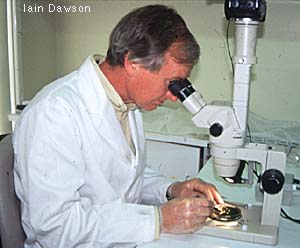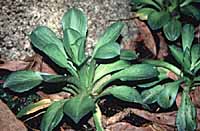![Director of National Parks [logo]](/images/dnp_90px.gif)


![Director of National Parks [logo]](/images/dnp_90px.gif) |
 |
 |
Some people get the interesting jobs. When the Australian National Botanic Gardens (ANBG) in Canberra collected some edible plants from Heard and Macquarie Islands, (described in article1 and article 2 of this series) someone had to taste them.
The job fell to a trained tasting panel at the Department of Food Science and Technology at the University of New South Wales, in Sydney.
The Department has people who are expert in nutritional analysis of foods. It is the academic institution that publishes most of the food composition tables for Australia. It measures things like vitamins, calories, protein, carbohydrate etc., in foods.
If the food being studied is a new one, like the Macquarie Island cabbage for example (having first been determined to be edible and non-toxic), it is run past a specialised tasting panel to give a sensory profile. The panel uses a scoring system which tells the food scientists certain things.
How does the 'new' vegetable taste ? Nice or nasty ?
What kind of an aroma does it have ? Is there a touch of parsley flavour, or an aroma of cinnamon, perhaps ?
What is its texture and its after taste ?
Also very important - would the food be a nice thing to have on your plate ?
In the case of the ANBG's experiments, the tasting panel assessed the nutritional and taste qualities of three plants - Stilbocarpa polaris (Macquarie Island cabbage), Pringlea antiscorbutica (Kerguelen cabbage from Heard Island) and Callitriche antarctica (which resembles watercress and comes from Macquarie Island). The University of New South Wales became involved in the subantarctic foods project after the ANBG in Canberra received a grant from the Rural Industries Research and Development Corporation for the food analysis and to determine whether the plants could be grown commercially.
The next step was to 'write up' the results of the tests so the ANBG could approach industry if the vegetables promised to be commercially attractive.
 After
Canberra botanist Jim Croft and horticulturalist Stuart Donaldson had collected
the Macquarie Island and Heard Island plants in 1989 and 1993 and planted them
out into a small subantarctic garden at the Black Mountain site, the work of
studying their commercial development was taken up by plant physiologist Iain
Dawson.
After
Canberra botanist Jim Croft and horticulturalist Stuart Donaldson had collected
the Macquarie Island and Heard Island plants in 1989 and 1993 and planted them
out into a small subantarctic garden at the Black Mountain site, the work of
studying their commercial development was taken up by plant physiologist Iain
Dawson.
As well as the little outdoor garden, the three edible plants were being grown successfully in the Botanic Gardens' 'Macca Room' - so named because of its Macquarie Island contents. The room is kept at a temperature between 12 and 15 degrees C.
Iain Dawson's studies of the plants, with the help of the Rural Industries Research and Development Corporation grant are designed to see if the plants can be grown in commercial quantities and to find out if they have nutritional value. Also most important is to see whether the general population can be persuaded to eat them.
Dawson says new vegetables have become commercial in Australia for all sorts of reasons. One reason is the increase in diversity of fresh vegetable products being consumed in Australia these days. This has happened because Australians now travel more and we have broadened our taste for unusual foods. Migration has brought us many Asian vegetables that were once 'foreign' to us. We are also more affluent, with the result that we look for more variety in our foods. There is even a fashion component in what we eat.
Where once we might have looked only for some cress and sprouts from the 'niche market', we now find a wide range of salad sprouts, potato varieties, lettuces, Asian green and root vegetables.
New vegetables like those from the subantarctic region, Dawson says, would also be relatively simple to promote in the market because of their unusual origins.
 In
the 'Macca room' at the Black Mountain gardens, Iain Dawson allowed me to do
my own taste test of Pringlea antiscorbutica and Callitriche antarctica.
Both had a light peppery taste, a bit like water cress, although by tasting
the P. antiscorbutica (the Kerguelen cabbage) first, I probably spoilt
the taste of the C. antarctica. But I agreed with Iain, that they would
both go nicely with some smoked salmon and lemon.
In
the 'Macca room' at the Black Mountain gardens, Iain Dawson allowed me to do
my own taste test of Pringlea antiscorbutica and Callitriche antarctica.
Both had a light peppery taste, a bit like water cress, although by tasting
the P. antiscorbutica (the Kerguelen cabbage) first, I probably spoilt
the taste of the C. antarctica. But I agreed with Iain, that they would
both go nicely with some smoked salmon and lemon.
 The
Stilbocarpa polaris (Macquarie cabbage) was in the cool room too, but
not in an edible quantity. Iain Dawson's own findings show that this one is
too slow to grow and too 'fiddly' to prepare. It is also too fibrous, although
records show that this did not deter the sealers last century who were known
to eat the 'wild cabbage' as an effective remedy for scurvy. They prepared the
plants by scraping the stalks and roots, chopping them finely and making a cabbage
flavoured stew.
The
Stilbocarpa polaris (Macquarie cabbage) was in the cool room too, but
not in an edible quantity. Iain Dawson's own findings show that this one is
too slow to grow and too 'fiddly' to prepare. It is also too fibrous, although
records show that this did not deter the sealers last century who were known
to eat the 'wild cabbage' as an effective remedy for scurvy. They prepared the
plants by scraping the stalks and roots, chopping them finely and making a cabbage
flavoured stew.
One account (Sinclair - 1877-78) describes Christmas dinner on Macquarie Island as consisting of :
"corned beef and an herb that grows here which we call cabbage, potatoes, elephant (seal) tongue, curried parakeets, penguins' tongues, hearts and livers, which are first rate, preserved meat, a roly-poly made of blackcurrant jam".
Despite such an exotic Christmas experience by a crew of sailors more than 100 years ago, Dawson says at present the Macquarie cabbage is not commercially attractive. However, it might be possible to improve it with new varieties.
Callitriche antarctica, on the other hand has another problem, despite its potential as a complement to smoked salmon. It has some interesting medical properties, such as iridoid glucosides (liver protecting qualities) and verbascocide (anti-inflammatory, anti-microbial and anti-tumour effects), but Dawson says it could also become an aquatic weed if grown in Australian mainland conditions. This leaves us with Pringlea antiscorbutica - the other one with anti-scurvy properties.
Although gathered by Canberra horticulturalist Stuart Donaldson on Heard Island, it takes its name of Kerguelen cabbage from the nearby French protected Ile Kerguelen, where it was first described by British physician and founder of modern military medicine, Sir John Pringle (1707-1782).
Early British expeditioners to the Antarctic cooked it alone or boiled it with the ship's beef, pork or pea soup.
The Kerguelen cabbage has shown so far that it will grow well in Australia and that it has commercial potential.
But Iain Dawson says it is not necessarily remarkable that a plant like Pringlea antiscorbutica from the subantarctic will grow well on the Australian mainland. 'Just because a plant grows in the subantarctic doesn't always mean it won't grow better somewhere else', he says. 'There's sometimes a mistake to look for the same environment'. He gives as an example the plant jojoba, which is native to Mexico and south-western US and has a seed containing a liquid wax that is useful as a high temperature and pressure lubricant and in cosmetics. 'We have been through that with jojoba - that it could grow in their deserts and yet it grows in our wheat belt,' he says. 'You have to define the environmental limits'.
Dawson says similarly, there are places in Australia where we may grow subantarctic plants commercially, in an environment quite different from their original habitat. And they may not even be grown in soil. They could be grown as sprouts or hydroponically.
'In commerce you create whatever soil you need', he says. The commercial development of Australian flora is something of a specialty of Iain Dawson and it is not just the subantarctic plants that interest him. But that is another story....
By Jan Smith